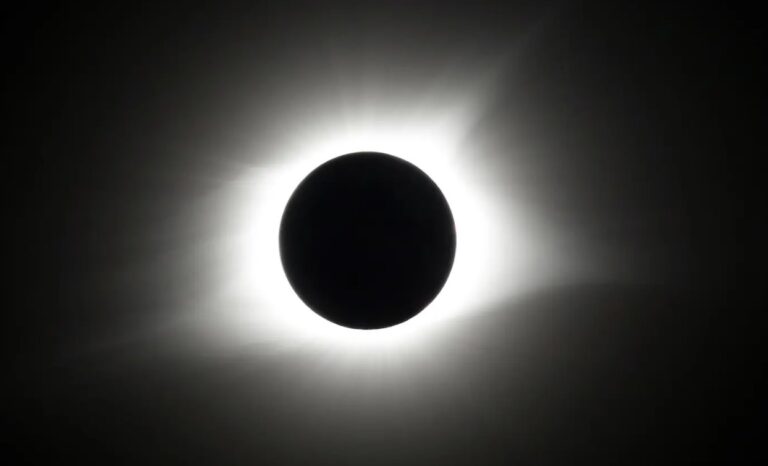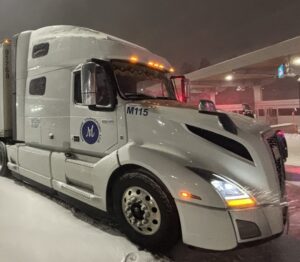BENTON, Ark. — On a recent afternoon at a Pilot truck stop along Interstate 30 in central Arkansas, professional truck driver James “T-Bone” Jackson nearly choked on a bite of his Subway ham sandwich when asked if he’d shut down his rig during the 2024 eclipse.
“What are you talking about?” he said, gulping soda to wash down that chunk of sandwich. “That’s the craziest shit I’ve ever heard of.”
Jackson said he didn’t know about the Arkansas Department of Transportation’s (ARDOT) suggestion that truck drivers take a holiday on April 8, 2024, when much of the Natural State will be in line to see a full solar eclipse.
After being told about ARDOT’s plan, he said he’s against it.
“Total crap,” he said of the plan before diving his left hand into a bag of potato chips.
ARDOT proposes a trucking holiday in its 2024 eclipse traffic management plan (TMP) as one of many suggestions to help ease traffic around the state during the eclipse.
“We expect a heavy influx of visitors to our state to view this rare phenomenon, and we’re preparing accordingly,” said ARDOT Director Lorie Tudor. “Our goal is to get everyone where they need to go as safely and efficiently as possible.”
The 2024 eclipse TMP includes traffic forecasting data, traffic reduction strategies and traffic flow enhancements, as well as information about ARDOT’s Traffic Management Center and Communications Division.
ARDOT officials said in a news release they used data from states in the path of the 2017 total solar eclipse, along with state park reservation data for the upcoming eclipse, to help anticipate travel patterns and peak travel dates and times.
“With this data, ARDOT was able to identify locations where high or extreme traffic volumes are expected immediately following the eclipse,” the news release said. “The TMP includes traffic reduction strategies such as: stay a while, work from home, school closings, reduce oversize loads and a communication effort with truckers so they can make an informed decision on their travel plans. The TMP also includes traffic flow enhancements such as: reduced construction activity, identify and mitigate potential bottlenecks, and suggest alternate routes to avoid traffic chokepoints.”
ARDOT says it will coordinate with other agencies and officials at the state, county and local levels before, during and after the eclipse “to ensure consistent messaging and communication is provided to citizens and visitors.”
In the TMP plan specific to truck drivers, ARDOT officials wrote: “Severe congestion is expected on the entire Arkansas state highway system during the eclipse, to such an extent that the day may be mostly unproductive for freight vehicles.
“ARDOT will engage the Arkansas Trucking Association in an effort to encourage truckers to adjust their travel schedule, so they are not trapped on the roadways with eclipse related traffic,” the statement continued. “Like other strategies discussed, this will be a voluntary decision on the part of the commercial drivers with no penalty for those who decide to operate during the eclipse.”
Arkansas Trucking Association President Shannon Newton, like Jackson, isn’t warm to the idea of a trucking holiday.
“I don’t think that it’s a realistic expectation that we’re going to stop interstate commerce for 24 hours,” she said in a statement. “I think there is value in informing members of the industry just so that we can appropriately set expectations.”
Newton says she doesn’t expect any trucking company in the state to have its plans made until closer to the event.
What about independent truck drivers? Jackson says he doesn’t think many truckers will heed ARDOT’s advice.
“You can’t just park your rig for a tourist event,” he said. “We have bills to pay and products to deliver. That doesn’t stop for anything.”
Two tables over from Jackson, at the truck stop’s Subway restaurant, professional truck driver Susan Sanders said she’s read ARDOT’s eclipse plan.
Between bites of a turkey sub, she spoke freely about her opinion of the TMP. First, she laughed, then she batted her eyes several times before holding out her well-manicured hands.
“Honey, if I park my rig, you won’t be getting my load of chicken for dinner,” she said. “That’s what happens when you park big trucks. You don’t eat. You see what I’ve got in my hands here? Nothing. And that’s just what happens when you try to park my truck.”
Click here to view the full ARDOT traffic plan for the total eclipse.
ECLIPSE INFORMATION
On April 8, 2024, the moon will cast its shadow across a stretch of the U.S., Mexico and Canada, plunging millions of people into midday darkness.
It’s been less than six years since a total solar eclipse cut across the U.S. from coast to coast. That was on Aug. 21, 2017.
If you miss next year’s spectacle, you’ll have to wait 20 years until the next one hits the U.S. But that total eclipse will only be visible in Montana and the Dakotas.
WHERE CAN I SEE IT?
The predicted 2024 eclipse will slice a diagonal line across North America Monday, April 8. It will start in the Pacific Ocean and first reach land over Mexico around 11:07 a.m. local time, NASA predicts. Then, it’ll cross over into Texas and move across parts of the Midwest and Northeast in the afternoon.
All in all, the 2024 eclipse will cross portions of 13 U.S. states — Texas, Oklahoma, Arkansas, Missouri, Illinois, Kentucky, Indiana, Ohio, Pennsylvania, New York, Vermont, New Hampshire and Maine. Cities in the path of the eclipse path include Dallas; Little Rock, Arkansas; Indianapolis; Cleveland; and Buffalo, New York.
Parts of Canada, including Quebec and Newfoundland, will also get a glimpse before the eclipse heads out to sea in the early evening.
The total eclipse will be visible within a 115-mile wide swath (the path of totality). Outside that path, watchers can still see a partial solar eclipse, where the moon takes a “bite” out of the sun, creating a crescent shape.
Total eclipses happen about every 18 months, but many times they cross over remote areas and are seen by few people.
WHAT HAPPENS DURING AN ECLIPSE?
Solar eclipses occur when the moon passes in between the Earth and the sun, blocking the sun’s light from reaching the planet.
Even though the moon is about 400 times smaller than the sun, it’s also about 400 times closer to Earth, explains University of Colorado astronomer Doug Duncan. So, when the orbits line up just right, that little moon can block out the whole sun. Those standing in the right spots will experience totality, when the moon casts its shadow over the landscape.
“In just seconds, you go from bright, bright daylight to like the middle of the night,” said Dr. Debby Brown, who saw her first total eclipse in 2017 with Duncan in Grand Teton National Park in Wyoming.
“The stars are out. All of a sudden, all the animals are quiet,” recalled Brown, of Arlington, Virginia.
During the 2024 eclipse, totality will stretch to around four and a half minutes — almost twice as long as in 2017.
WHAT’S THE BEST SPOT?
To catch the full eclipse experience, planning ahead is key, Duncan said. Weather could be a big factor because the eclipse is in the spring, when conditions are unpredictable. Duncan says that’s why he selected Texas for his eclipse tour next year, where there are better odds of clear skies.
The best location also depends on what kind of experience you’re looking for, said Bob Baer, who’s coordinating eclipse plans at Southern Illinois University in Carbondale.
Carbondale, which is in the crossroads of both the 2017 and 2024 eclipse paths, will hold a viewing event at the school’s stadium. It’s a big group experience, Baer said, noting that during “the last 20 minutes before totality, the stadium gets as loud as a football game.”
But you can find eclipse events of all different flavors planned along the eclipse path — luxury cruises in Mexico, music festivals in Texas, farm camping in Arkansas, planetarium visits in upstate New York, and more.
“The goal, at the end of the day, is to get as many people outside as possible, looking up during totality,” said Dan Schneiderman, who is helping the Rochester Museum and Science Center plan events. “Hopefully with their close friends and loved ones.”
You’ll want to grab eclipse glasses to see the partial phases before and after totality, Schneiderman added. Looking at the partially covered sun without protection can cause serious eye damage.
Brown and her husband are planning to join Duncan’s eclipse tour in Austin. Her first eclipse experience flew by.
“I’m looking forward to being able to enjoy this even longer,” Brown said. “To be able to just lean into the moment.”
The Associated Press contributed to this report.
Born in Pine Bluff, Arkansas, and raised in East Texas, John Worthen returned to his home state to attend college in 1998 and decided to make his life in The Natural State. Worthen is a 20-year veteran of the journalism industry and has covered just about every topic there is. He has a passion for writing and telling stories. He has worked as a beat reporter and bureau chief for a statewide newspaper and as managing editor of a regional newspaper in Arkansas. Additionally, Worthen has been a prolific freelance journalist for two decades, and has been published in several travel magazines and on travel websites.
















Driving commercially is getting to be like trying to have a horse race where the horse’s veterinarian rides beside the horse riding a motorcycle to make sure the horse is being treated right.
lol what’s next to reduce traffic when it rains park when wind park when snow park yea not going to happen why does the Arkansas dot not advice the general public to stay of highway and major trough fares so trucks can do there jobs more efficiently and not being in the way of the general public.
All they can hope for is a cloudy day…..